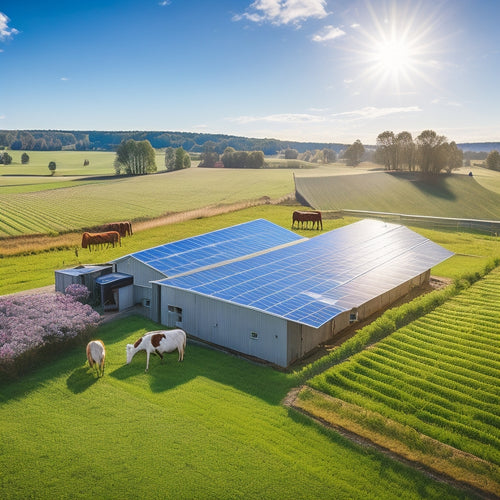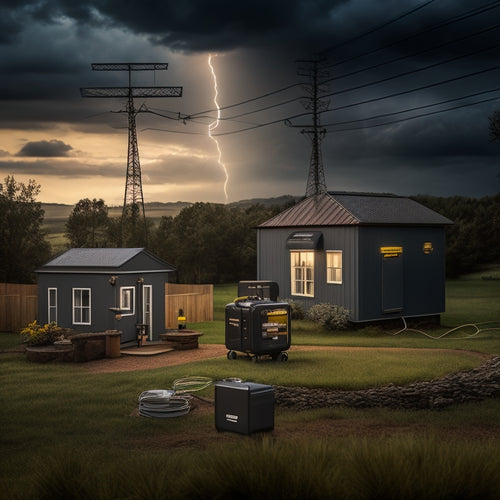
Renewable Energy for Home
Share
You can reduce your carbon footprint easily by incorporating renewable energy sources like residential solar panels into your home. Start by evaluating your roof's shading to determine ideal solar panel placement and identify obstructions like trees that may cast shade. You'll want to examine your roof's layout, considering materials, orientation, and pitch, to plan for trimming or removing obstructions and enhance energy production. By understanding zoning regulations and building codes before installation, you can begin to utilize free solar energy and reduce your reliance on the grid. Now, let's get started on making your home more energy efficient and exploring ways to enhance your renewable energy setup.
The Essentials
- Incorporate rooftop solar panels to harness free solar energy and reduce reliance on the grid, evaluating roof shading for optimal placement.
- Utilize energy-efficient appliances and replace incandescent bulbs with LED bulbs to lower energy consumption and reduce carbon footprint.
- Conduct energy audits to identify areas for improvement and explore financing options for renewable energy investments, optimizing energy usage.
- Implement inverter monitoring systems to track energy production in real-time, optimizing renewable energy setup performance and identifying areas for improvement.
- Take advantage of solar incentives and utility rebates to further reduce costs, while adopting eco-friendly habits and lifestyle changes for a greener home environment.
Reduce Carbon Footprint Easily
You can reduce your carbon footprint easily by making conscious choices at home, and it starts with going green.
By incorporating renewable energy sources, such as Residential Solar Panels, and energy-efficient appliances, you'll not only contribute to a sustainable future but also lower your energy bills.
Additionally, switching to renewable energy can help you save money on your electricity costs and reduce your reliance on the grid.
Go Green at Home
By incorporating simple, eco-friendly habits into daily routines, homeowners can greatly reduce their carbon footprint and contribute to a more sustainable future. You can start by making small changes, such as switching to energy-efficient light bulbs and turning off appliances when not in use. This not only reduces your energy consumption but also increases the solar panel benefits, as you'll be generating more clean energy than you're using.
| Eco-Friendly Habits | Energy Efficiency | Solar Panel Benefits |
|---|---|---|
| Use public transport or walk/bike | Reduces energy consumption | Increases clean energy generation |
| Insulate your home | Reduces heat loss | Optimizes energy usage |
| Use eco-friendly cleaning products | Reduces toxic waste | Contributes to a healthier environment |
| Plant trees and gardens | Absorbs CO2 | Supports biodiversity |
Lower Energy Bills
A typical household spends a considerable portion of its budget on energy bills, which can be a substantial burden on the wallet. By incorporating renewable energy sources into your home, you can markedly reduce your energy bills and enjoy utility savings.
One of the most effective ways to achieve this is by improving energy efficiency. This can be done by installing energy-efficient appliances, insulation, and windows, which will reduce the amount of energy consumed in your home.
By installing rooftop solar panels, you can utilize free, renewable energy from the sun, reducing your reliance on the grid and lowering monthly electricity bills. Additionally, solar panels increase your home's value and appeal, making it a more attractive selling point should you decide to move.
You can also consider investing in renewable energy systems such as solar or wind power. These systems generate electricity from natural resources, reducing your reliance on traditional energy sources and lowering your energy bills.
Additionally, many governments offer incentives for homeowners who invest in renewable energy, which can help offset the initial cost of installation.
Lower Your Energy Bills
You can greatly cut energy costs now by incorporating renewable energy sources into your home.
With the help of efficient and durable house solar panels, you can utilize the power of solar energy and reduce your reliance on traditional energy sources.
By doing so, you'll reduce your monthly expenses and allocate that money towards more important things.
With renewable energy, you'll be able to power your home while keeping your wallet happy.
Cut Energy Costs Now
Cutting energy costs is a top priority for homeowners, and for good reason: it's a surefire way to free up more money in your budget for the things that matter. You can start by implementing some simple energy efficiency tips. For instance, replace traditional incandescent bulbs with LED bulbs, which use considerably less energy and last longer.
You can also adjust your thermostat to use less energy for heating and cooling. Additionally, seal air leaks and add insulation to prevent heat from escaping.
Smart home technology can also play a considerable role in cutting energy costs. Consider investing in a smart thermostat that can learn your schedule and preferences to optimize your home's temperature.
You can also install smart plugs that allow you to control and monitor the energy usage of individual appliances. By taking these steps, you'll be able to reduce your energy consumption and lower your energy bills.
With the money you save, you'll have more freedom to allocate your resources as you see fit.
Reduce Monthly Expenses
Every month, approximately 5% of your take-home pay goes toward paying energy bills, a considerable expense that can be reduced with the right strategies. By investing in renewable energy for your home, you can lower your energy bills and allocate that money to more important things.
Conducting an energy audit is a great starting point to identify areas of improvement in your home's energy efficiency. You can then take advantage of solar incentives, utility rebates, and government grants to offset the cost of upgrading to renewable energy systems.
Financing options are also available to make these investments more accessible. Renewable investments, such as solar panels and energy storage systems, can greatly reduce your reliance on the grid and lower your monthly expenses.
Grid-Tie Inverter Functionality
When you install a grid-tie inverter in your home, you'll have access to advanced monitoring capabilities, which is especially important when considering the efficiency of your residential solar panels and overall renewable energy solutions.
You'll be able to track your energy production in real-time, monitoring your system's performance and identifying areas for improvement.
Your inverter's monitoring system will also provide detailed data on your energy output, helping you optimize your renewable energy setup.
Inverter Monitoring Systems
Your grid-tie inverter's monitoring system plays an essential role in optimizing your renewable energy setup's performance. It provides real-time data on your inverter's operation, allowing you to identify areas for improvement and take corrective action.
This data is vital for maintaining peak inverter performance, which directly impacts your energy production and savings. Through the monitoring system, you can track your inverter's performance metrics, such as output power, voltage, and current.
This information enables you to detect potential issues before they escalate, ensuring timely system maintenance and minimizing downtime. You can also receive alerts and notifications in case of system faults or anomalies, allowing you to respond promptly and prevent energy losses.
Energy Production Tracking
As you examine the world of renewable energy, you're likely curious about how your grid-tie inverter tracks energy production. A key functionality of grid-tie inverters is energy production tracking, which allows you to monitor your system's performance and optimize energy consumption.
This feature provides real-time data on your energy production, enabling you to identify areas for improvement and increase production efficiency.
The inverter's tracking system measures the DC power output from your solar panels and converts it into AC power for your home. It then compares this output to your energy consumption, providing a net meter reading that indicates whether you're producing more energy than you're consuming.
This data is essential for understanding your energy usage patterns and making informed decisions about your energy needs.
Assess Your Roof's Shading
You'll need to evaluate your roof's shading to determine the ideal placement of solar panels.
Consider the obstructions that cast shade on your roof, including trees, chimneys, vents, and skylights, as they can greatly impact energy production.
By investing in renewable energy solutions, you can reduce your reliance on the grid and lower your utility bills.
Additionally, with proper analysis of shading patterns over time, you can identify the most suitable areas for panel installation and optimize your system's performance.
Roof Obstructions to Consider
Take stock of your roof's layout to identify potential obstructions that could cast shade on your solar panels. Roof materials, solar orientation, and roof pitch all play an important role in determining the amount of shade your panels will receive.
Evaluate the structural integrity of your roof to guarantee it can support the weight of the solar panels. Installation obstacles, such as vents, skylights, and chimneys, may require additional planning and design to guarantee a successful installation.
Zoning regulations and local building codes may also impact your solar panel installation, so it's vital to research these regulations beforehand.
Maintenance access is another significant factor to evaluate, as you'll need to guarantee easy access to the panels for cleaning and repairs.
Aesthetic considerations, such as the color and style of the panels, should also be taken into account to guarantee they blend seamlessly with your home's design.
Shading Patterns Over Time
Your roof's layout and structural integrity are just the beginning. Now, you need to take into account shading patterns over time. A shading analysis is vital to determine how much sunlight your roof receives throughout the day and year. This analysis will help you identify areas with partial or complete shading, which can greatly influence your solar panel system's performance.
Seasonal variations also play a major role in shading patterns. During winter, the sun is lower in the sky, resulting in longer shadows. In contrast, the sun is higher in the sky during summer, reducing shadows. You'll need to factor in these changes to guarantee your solar panel system operates at its peak level.
To conduct a thorough shading analysis, you'll need to assess your roof's orientation, nearby obstructions, and tree coverage. You can use online tools or consult with a professional to create a detailed shading report.
This report will provide you with a clear understanding of your roof's shading patterns, enabling you to make informed decisions about your solar panel system's design and installation.
Higher Energy Conversion Rate
You can maximize solar output by optimizing your solar panel's energy conversion rate, which is the percentage of sunlight converted into electrical energy.
A higher conversion rate means more power generated per hour of sunlight. By choosing high-efficiency panels and ensuring proper installation, you can increase your system's overall energy production.
Maximizing Solar Output
Optimizing solar panel installation and maintenance is vital to maximize solar output and achieve a higher energy conversion rate.
You'll want to verify your solar panels are installed at an ideal tilt to capture the most sunlight. The ideal tilt angle varies depending on your location, but a general rule of thumb is to tilt your panels at an angle equal to your latitude. For example, if you live at a latitude of 30°, your solar panels should be tilted at 30°.
Proper solar panel placement is also important, as shading from trees, buildings, or other obstructions can greatly reduce energy output.
You should also regularly clean your solar panels to remove dirt and debris that can hinder energy production.
Frequently Asked Questions
Can I Install Renewable Energy Systems Myself?
You can attempt a DIY installation, but it's essential to verify system compatibility, as incorrect pairing can lead to reduced efficiency or even safety hazards, so it's recommended to consult professionals for best results.
Are Government Incentives Available for Home Renewable Energy?
You'll find government incentives, like tax credits and energy rebates, available to offset installation costs; research federal and state programs, such as the Solar Investment Tax Credit, to maximize your savings and accelerate your shift to renewable energy.
Will Renewable Energy Systems Affect My Property Value?
Like a gem on a velvet cloth, your property value will shine brighter with renewable energy systems, as a property assessment will likely increase, aligned with market trends that favor eco-friendly homes, giving you the freedom to reap the benefits.
Can I Use Renewable Energy During a Power Outage?
When the grid goes down, you'll stay powered up with a solar battery or wind turbine system, allowing you to capture and store energy independently, giving you the freedom to ride out outages without interruption.
How Long Does It Take to Recoup the Cost of Renewable Energy Systems?
Ah, you want to know when you'll break even on your eco-friendly investment? Well, buckle up, freedom fighter! Your payback period depends on a thorough cost analysis, but on average, it takes 5-10 years to recoup the cost of renewable energy systems.
Final Thoughts
It turns out you're among the growing number of homeowners keen on reducing their carbon footprint and saving on energy bills. Coincidence? Maybe, but it's a great coincidence! By now, you've learned how to utilize renewable energy for your home, from evaluating your roof's shading to leveraging grid-tie inverter functionality and achieving a higher energy conversion rate. The next step is yours: take control of your energy future and start enjoying the benefits of renewable energy today.
Related Posts
-

What Do I Need to Know About Farm Solar Panels
When considering farm solar panels, you need to assess costs, benefits, and technical specifics. Initial investment c...
-

Smart Home Thermostats to Revolutionize Your Space
Smart home thermostats revolutionize your space by providing precise temperature control and optimizing energy saving...
-

Key Components of a Reliable Emergency Power Supply System
A reliable emergency power supply system requires several key components. You need proven performance metrics to guar...


